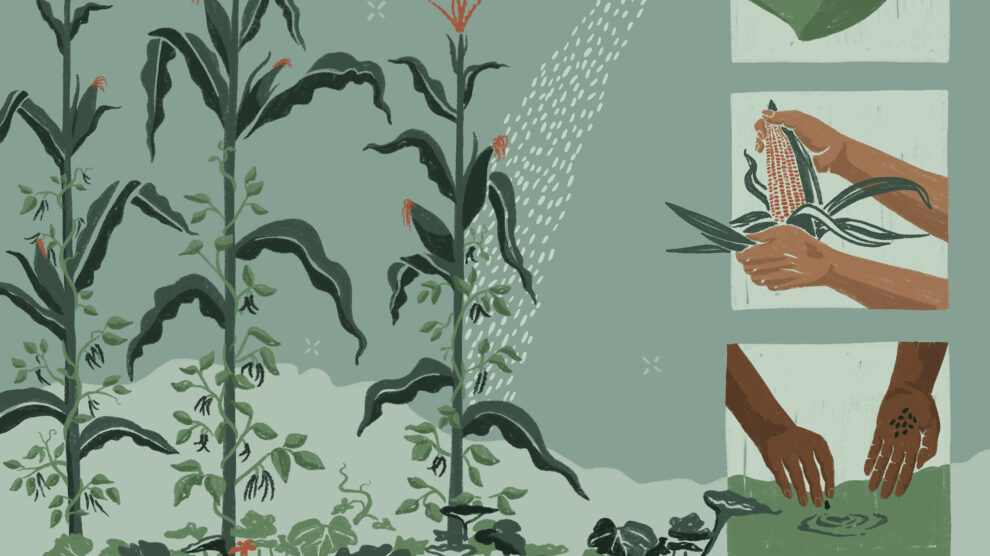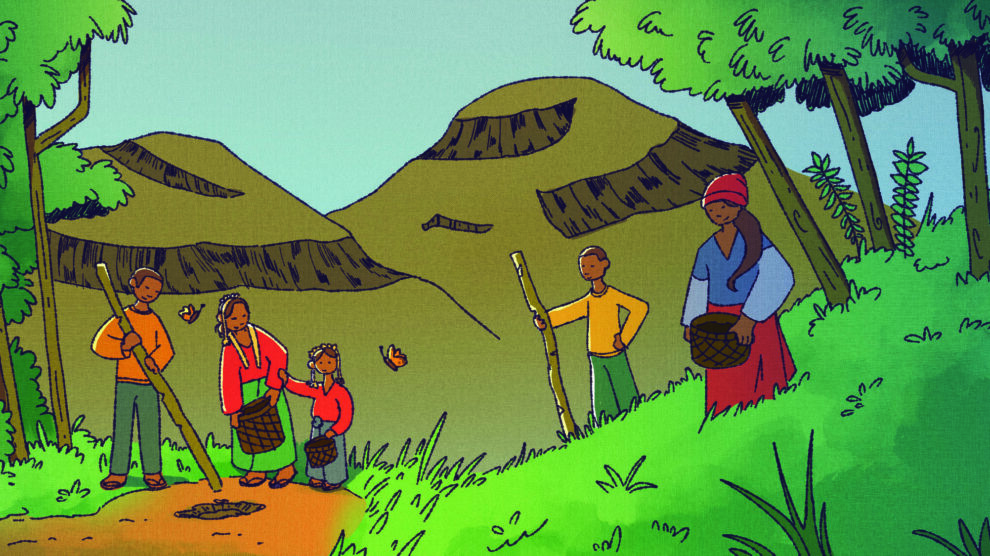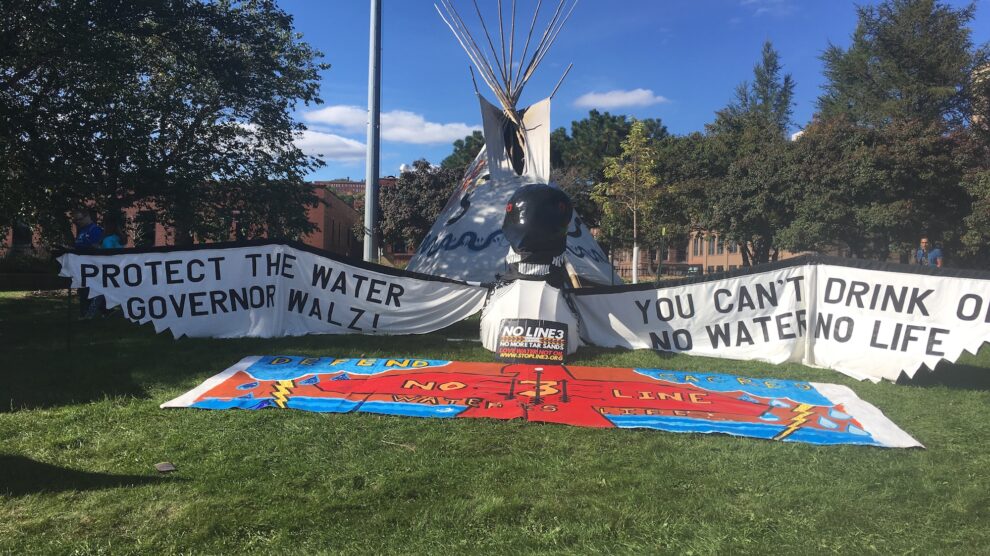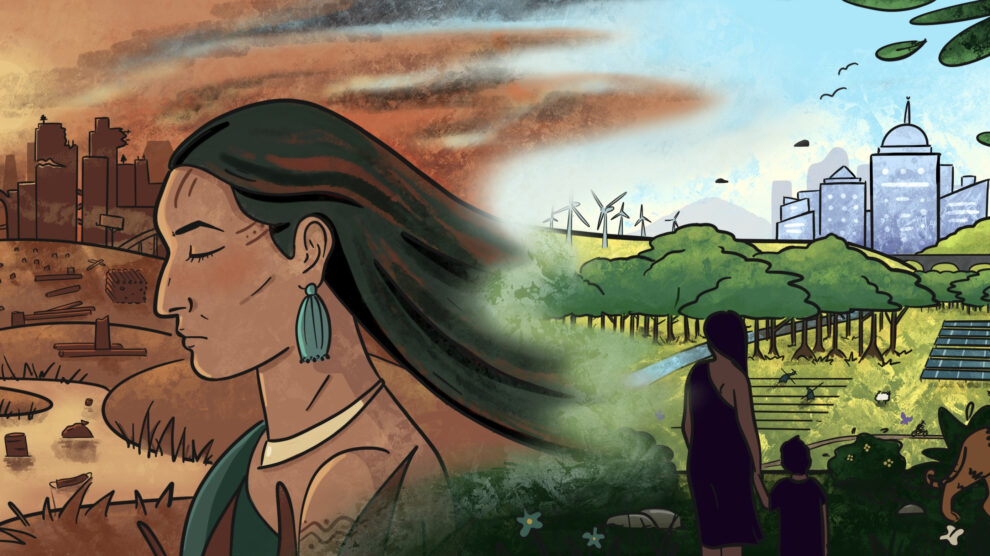Asking the Cattails Why They Are Here
Charles Elton, Anishinaabe Aki, and the Unsung Roles of Cooperation in Invasion Ecology
Promita Ghosh and Amitava Banerjee
Volume 24, no. 3, Cooperation: Theory and Practice for the Commons
“The cattail marsh has something in common with the Emporium, but I suppose a comparison to Walmart is more appropriate, as they both sprawl over acres of land.”
—Robin Wall Kimmerer in Braiding Sweetgrass
Cattails are a common marsh plant that provide food, fuel, shelter, and medicine to Professor Kimmerer’s ethnobotany fieldwork students, who forage for wild plants as part of course exercise described in her 2013 book Braiding Sweetgrass.1 If left unchecked, cattails can clog waterways, harm agriculture and fisheries, and host other species, such as blackbirds, which can cause further crop damage. Fast growing, tall standing, and rapidly spreading via both seeds and specialized root systems, cattails have perfected numerous adaptations to invade, occupy, and thrive in wetland ecosystems, with consequences for the local plants, animals, soil, and water.
And yet, “this is all good for the plant, of course—and it’s good for people,” insists Kimmerer, a State University of New York Distinguished Teaching Professor of Environmental Biology and an enrolled member of the Citizen Potawatomi Nation.2 This view of cattails as good for the people contravenes the widely held view of them as invasive. Indeed, Indigenous knowledge has been delegitimized in the eyes of what we now know simply as “science.” Invasiveness is an example of an ecological concept that has been widely theorized and extrapolated upon within the scientific establishment but which may be flawed at its base.
Most of the Western scientific literature on non-native (so-called “invasive”) species focuses on portraying non-native species as a potential threat to the sustainability of existing colonial economies, which are dependent on native plants and animals.3 The field of invasion ecology, which considers the effects of non-native plant and animal species on ecosystems, economy, and public health, began with the publication of The Ecology of Invasions by Animals and Plants (1958) by the preeminent British ecologist Charles Elton.4 According to Google Scholar, the book has been cited over eight thousand times, with about one fifth of all citations from the last five years. Elton is also credited with the development of many of the core concepts of ecology, including the ecological pyramid and niche, the food chain and food cycle, population dynamics and explosion, and the effects of human activities on species migration and redistribution.
In theorizing invasion ecology, Elton hypothesized that species-rich communities are less vulnerable to invasion by non-native species. This notion, that ecosystems with greater biodiversity have fewer unoccupied ecological niches, leaving little or no opportunity for non-native species to gain a foothold, is the premise of the “biotic resistance hypothesis,” also called the “biodiversity–invasibility hypothesis.”5 Elton viewed the relationships between natural communities as being mediated by mostly negative interactions, such as competition and parasitism, and believed that higher species diversity impedes invasion by using up available ecological resources. Elton further argued that simpler food webs like those of remote islands are more vulnerable to invasion, whereas more complex food webs like those in cultivated or habitable lands experience reduced interference from invaders. This discourse, crucially centered on competition between species over resources, fails to acknowledge the significance of non-native species in stabilizing energy flow and biotic organization of ecosystems.
“Before you were born, Wazhushk, your grandmother sewed you a little bag of deerskin embroidered with red thread and blue beads. This bag was for your odissimaa, that small stem left from the cord that connected you to your mother before you were born. When you were only a few days old the stem had dried and fallen from your little belly; your grandmother wrapped it in cattail fluff and placed it into the bag.”
—Linda LeGarde Grover in The Road Back to Sweetgrass6
Cattails provide den-building materials for the wazhushk (meaning “muskrat” in zhaaganaashiimowin7) and safe cover for deer. Understanding the relationship between native and non-native species at all levels of an ecosystem is a complex task. There are numerous variables: geographical isolation, behavioral nuances, resource availability, climate variation, competition, migration, and invasions, all of which modulate species interactions over various space and time scales.
Growing evidence of successful coexistence and mutualism between native and non-native species began to emerge in a number of studies around the turn of the century, generating profound criticisms of Elton’s widely accepted hypothesis of invasion. For example, in 2004, Espinosa-García et al. built statistical models for the population of both native and non-native Mexican weed species. They found that native weeds, native non-weeds, and non-native weeds all had similar frequency distributions across Mexico, speaking to the richness of such flora in the region.8 Similarly, Martin-Albarracin et al. (2015) studied the impact of non-native birds on native ecosystems and reported seven species of non-native birds that displayed distinct positive interactions with the native community. Examples of such positive impacts included helping in seed dispersal in Hawaii in lieu of the extinct native dispersers, deterring common avian predators, making new holes in trees which could host native bird species, and forming multi-species flocks. All of these phenomena considerably modify ecosystem structure and function.9 Evidence of cooperation can also be found in the way native and non-native species work together to enhance nitrogen fixation, habitat modification, and pollination. In 2018, Northfield et al. documented indirect interactions showing that native species facilitate non-native invasion.10
Despite the widespread occurrence of such mutualistic relationships, these kinds of interactions were left out of Elton’s book and early studies that shaped the science of invasion ecology. Though invasion does not always lead to beneficial relationships between the native community and non-native species, the decision by pioneers like Elton to ignore how symbiotic relationships can yield fruitful associations has significantly hindered our understanding of community ecology and coexistence in general.
Considerations of coexistence and cooperation among humans, plants, and animals, though absent in the work of Elton and subsequent Western scientists, are central to the traditional knowledge and science of Indigenous Anishinaabe communities, who live in the region north of the Great Lakes.11 Such knowledge offers a more nuanced perspective on species migration, going beyond the native/non-native and useful/harmful binaries, as was documented in the work by Professors Nicholas Reo (a citizen of the Sault Ste. Marie Tribe of Chippewa Indians) and Laura Ogden.12
Professors Reo and Ogden conducted ethnographic research with Anishinaabe communities and found that despite having been greatly affected by ecosystem disruption from settler colonial species introduction, these communities view arrivals of new species as part of the natural migratory processes of plant and animal nations, without problematizing these processes. The Anishinaabe do not consider non-native species a nuisance; rather, they are more concerned with the land ideologies of the colonists who think of non-native species as “invaders.” According to Reo and Ogden, Anishinaabe knowledge values observations that can help to generate understandings of why new plants and animals have inhabited their lands and to investigate the nature of novel relationships between humans and newly-arrived species.
“I wonder if anyone has bothered to ask the Asian carp or the hybrid cattail why they are here?” Bud Biron, a cultural educator from the Sault Ste. Marie tribe, asked Reo and Ogden.13 Professor Enrique Salmón presented a similar concept to describe the perception by Indigenous communities of the other species surrounding them as kin: “kincentric ecology.” “Indigenous people view both themselves and nature as part of an extended ecological family that shares ancestry and origins,” he says, which supports their acceptance of the new species and builds the foundation of Indigenous ethical practices and stewardship.14 Dr. Deborah McGregor, Anishinaabe professor and Canada Research Chair in Indigenous Environmental Justice, has illustrated the Indigenous ideology buen vivir, which “calls for ‘living well’ within a community that extends to the natural world,” and viewing relationships between human and non-human beings as central to environmental sustainability.15 Unfortunately, Anishinaabe ecological theories and perspectives such as these are often devalued by colonially educated scientists because of their basis in community knowledge and because of interpretation biases deeply rooted in a colonial perspective. As a result, these perspectives are underrepresented in colonial scientific publications, which tend to perpetuate individualist, reductionist science, of the kind championed by Elton.
We shall not go further into the scientific critiques of Elton but instead will consider the contexts that led him to formulate his hypotheses and constrained his studies. Peder Anker observed in his 2001 book Imperial Ecology that “the formative period of ecological reasoning coincides with the last years of the British Empire,” and the field of ecology grew out of concerns over the best ways to manage natural resources on vast colonized lands so as to maximize their control and exploitation over a long period of time.16 “It is hardly possible to conceive a property owner or stores manager carrying on the management of a large estate or general store and yet being unaware of the stock at his disposal, the extent of his supplies or their nature,” says the preface of Aims and Methods in the Study of Vegetation, a 1926 handbook published by the British Empire Vegetation Committee.17 The monograph “was well-received by ecologists” and is one of the earliest treatises formally opening the call to scientists to “explore and chart the local vegetation for the colonial administrative institutions,” with “native labor at [their] disposal.”
A politically aware reading of Elton, his contemporaries, and their predecessors reveals that the earliest works in the ecology of plant and animal communities were rife with analogies with colonial human societies. These works were often written by either colonial politicians or scientists with direct conflicts of interest arising from their connections to powerful colonial funding agencies. A similar conflict of interest remains the norm in scientific research and publication today; the pharmaceutical industry and military contractors provide a huge amount of funding for scientific research.
Elton is thought to have been heavily influenced by his teacher at Oxford, Alexander Carr-Saunders, a eugenicist who used the ideas of eugenic statisticians like Francis Galton to develop theories of population growth and eugenic control.18 In his works, Elton recycled Carr-Saunders’s analogies between ecological food cycles, economic cycles, and class conflicts in industrial England; between ecological niches, “human mental characteristics,” and the division of labor; and between ecological pyramids and eugenic regulation of human populations—“to construct an order of nature that reflected and reinforced Carr-Saunders’s eugenic tendencies and Malthusian agenda of selected human superiority.”
“The question of the desirable number on a given area has received a great deal of attention from people studying the ecology of human beings. It is found that there is an optimum density of numbers for any one place and for people with any particular standard of skill,” writes Elton in Animal Ecology, before proceeding with an analogy of a farm employer who optimizes the number of workers by balancing a worker’s “standard of skill” with the “maximum return for his outlay.”19
Analogies are used in scientific works to promote popular understanding of scientific concepts by making connections and noting similarities to familiar phenomena. Colonial analogies in ecology were used to sell early ecological theories, likely to people who had internalized British imperialism as the natural global order. This also served the interests of British imperialism, economy, and racist science by reinforcing the claim that hierarchy and differences of abilities are hard-coded into nature, rather than arising as the outcomes of systems of social organization. For example, ecological succession of plant communities on the Cape of Good Hope was invoked to explain European colonization of Africa, and it was argued that “the reason why natives were on the losing side was that they had stopped evolving because of the African climate.”20
Theories of invasion ecology centered on competitive dominance and colonization of available ecological resources and niches. “Plants ‘establish themselves on soil “prepared” for them,’ higher forms of plants ‘kill out the lowly pioneers,’ and establish new plant ‘associations,’ ‘kingdoms,’ ‘societies,’ ‘clans,’ and ‘colonies,’ and certain species ‘dominate’ these ‘communities,’” explain Tansley and Chipp in Aims and Methods.21 In particular, the key rationale of the biotic resistance hypothesis, that native species can resist invasions by occupying all potential niches, parallels the concept of terra nullius, the legal principle that uncolonized land is nobody’s land and hence up for grabs. Terra nullius informed ecology in both theory and practice: in 1921, Elton and Carr-Saunders joined an all-male team from Oxford University on an “expedition” to the island of Spitsbergen.
Impacts of terra nullius laws on Indigenous peoples are blatantly obvious, as are attempts at erasure carried out by Elton and early ecologists toward Black and Indigenous peoples and their knowledge about the land. Elton’s seminal 1958 text, The Ecology of Invasions, repeatedly fails to acknowledge the effects of settler colonialism on Indigenous people and their ecosystems or to understand the nuanced relationship of Indigenous people with their land and environments. This omission is particularly noticeable because Elton emphasizes throughout the text that human activities are central to the introduction of non-native species into new ecosystems.
Over the course of the past century, the portrayal of Indigenous peoples by Western ecologists has only worsened. Indigenous communities were once portrayed as ignorant ecosystem-destroyers causing great nuisance to the colonization and capitalization of ecosystems and biodiversity. Now, in the eyes of the Western scientific establishment, they are agency-less, vulnerable people fighting to protect their surroundings, helpless in the face of non-native species ravaging their culture and traditions, leaving them to depend crucially on the science of their colonizers for survival.22 Clearly, Western ecology and science have yet to take any fundamental steps toward decolonization.23
The colonial baggage of Western ecology has steered the discipline toward the wrong conclusions, including overemphasis on competition and ecological management focused on the removal of invasive species to keep things “natural,” even when there is no ecological benefit to doing so or where doing so could actually weaken the ecosystem (for instance, with widespread and indiscriminate applications of pesticides and herbicides).
Indigenous ecology presents a more reliable understanding of mutualism and cooperation between species through a better understanding of species interactions and migrations. Many modern large-scale studies have reported larger populations of animals from lower vertebrates to large mammals and greater plant diversity on lands managed or co-managed by Indigenous communities, evidence that Indigenous knowledge and science may hold the key to a more sustainable approach to biodiversity and conservation.24 In her book Plants Have So Much To Give Us, All We Have To Do Is Ask, Anishinaabe scholar Dr. Mary Siisip Geniusz emphasizes the significance of cattails in protecting the shoreline of Northern lakes from erosion, naming them the “Defenders of the Shoreline” while also noting their importance as food, weaving material, and poison absorbers used to clean polluted water. “As land animals, humankind should be more grateful to those plants who hold the land in place for us,” she says, asserting that cattails are not an “inconvenience,” but can be both useful and economical for us.25 Species deemed “invasive” in Western ecology have many uses—cattails can be used in room-heating fuels, dandelions and plantains have medicinal properties, herbaceous garlic mustard is a fragrant seasoning, berries can be cooked into jams. Acknowledging the biotic relevance of non-native species and understanding their relationships with the environment and human beings, following Indigenous perspectives, will pave the path toward a robust mutualistic ecology and biodiversity preservation.
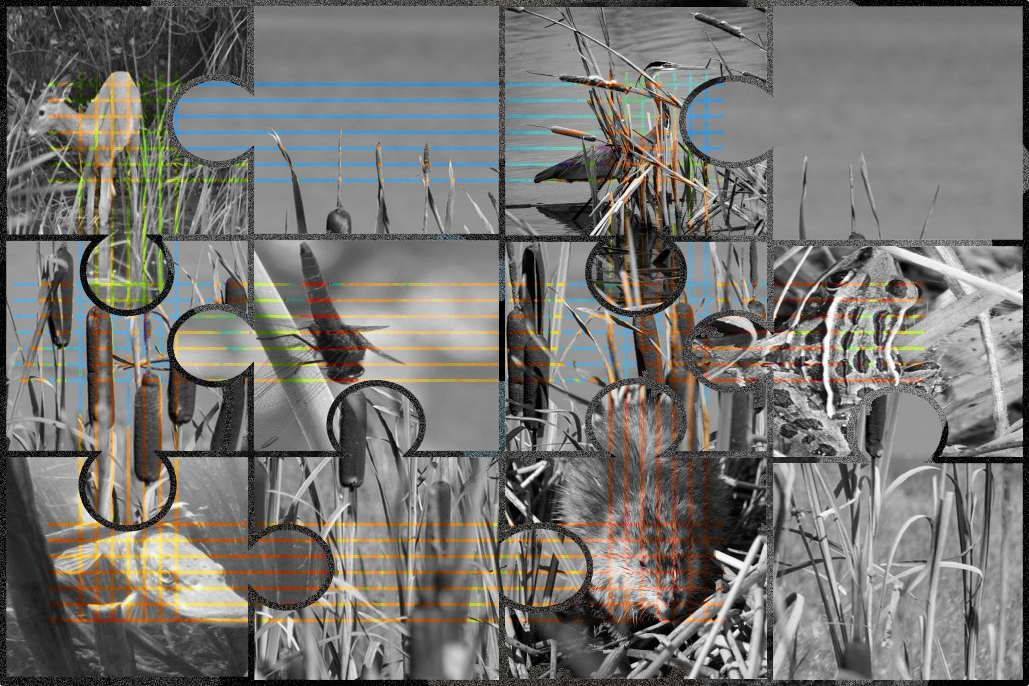 The jigsaw is inspired by the Woodland Style and depicts the harmonious coexistence of species. We have also made use of a recently popularized illusion called color assimilation, where desaturated images appear to be colored when a grid with oversaturated colors is overlaid. In our case, the black-and-white images of the animals (e.g., the deer, the muskrat, and the fish) appear colored. In this way, we convey the contrasting perspectives of Western and Indigenous ecologies. The use of binary colors, when the animals are focused individually, reflects the individualistic and linear perspective of Western ecology. The animals are evaluated on their duality of function of being either productive or unproductive in an ecological pyramid. However, the connections between the animals (represented herein by colored lines) reveal a holistic understanding of a mutually beneficial network that exists between the animals and “invasive species” like cattails.
The jigsaw is inspired by the Woodland Style and depicts the harmonious coexistence of species. We have also made use of a recently popularized illusion called color assimilation, where desaturated images appear to be colored when a grid with oversaturated colors is overlaid. In our case, the black-and-white images of the animals (e.g., the deer, the muskrat, and the fish) appear colored. In this way, we convey the contrasting perspectives of Western and Indigenous ecologies. The use of binary colors, when the animals are focused individually, reflects the individualistic and linear perspective of Western ecology. The animals are evaluated on their duality of function of being either productive or unproductive in an ecological pyramid. However, the connections between the animals (represented herein by colored lines) reveal a holistic understanding of a mutually beneficial network that exists between the animals and “invasive species” like cattails.
This article is part of our Winter 2021 issue: Cooperation. We will gradually post articles online in the coming months. Subscribe or purchase this issue to get full access now.
Notes
- Robin Wall Kimmerer, Braiding Sweetgrass: Indigenous Wisdom, Scientific Knowledge and the Teachings of Plants (Milkweed Editions, 2013), 223–240.
- Kimmerer, Braiding Sweetgrass, 228.
- For the majority of the text, we have used the terms “invasive” and “non-native” to refer to the external species which inhabit another habitat where they did not necessarily originate. Other terminologies used to describe the same in ecology are “exotic,” “introduced,” “colonizing,” and/or “alien.” We chose to adhere to “invasive” and “non-native” based on the context of the concepts we discuss here.
- Anthony Ricciardi and Hugh J. MacIsaac, “The Book That Began Invasion Ecology,” Nature 452, no. 7183 (2008): 34.
- Charles S. Elton, The Ecology of Invasions by Animals and Plants (Netherlands: Springer, 1958); David M. Richardson and Petr Pyšek, “Fifty Years of Invasion Ecology—the Legacy of Charles Elton,” Diversity and Distributions 14 (2008): 161–168; Jonathan M. Jeschke, “General Hypotheses in Invasion Ecology,” Diversity and Distributions 20 (2014): 1229–1234.
- Linda LeGarde Grover, The Road Back to Sweetgrass (Minneapolis: University of Minnesota Press, 2014).
- zhaaganaashiimowin means “the English language” in Ojibwe
- Francisco J. Espinosa-García, José Luis Villaseñor, and Heike Vibrans, “The Rich Generally Get Richer, but There Are Exceptions: Correlations Between Species Richness of Native Plant Species and Alien Weeds in Mexico,” Diversity and Distributions, 10, no. 5–6 (2004): 399–407.
- Valeria L. Martin-Albarracin, Guillermo C. Amico, Daniel Simberloff, and Martin A. Nuñez, “Impact of Non-Native Birds on Native Ecosystems: A Global Analysis,” PLOS ONE 10, no. 11 (2015): e0143070.
- Tobin D. Northfield et al., “Native Turncoats and Indirect Facilitation of Species Invasions,” Proceedings of the Royal Society B: Biological Sciences 285, no. 1871 (2018): 20171936.
- The same community is also known as Anishinaabe, Anicinape, Nishnaabe, Neshnabé, and Anishinaabek, among many other names. The authors do not identify themselves as belonging to these communities and do not intend to use the name or any information about the Anishinaabe Peoples in any definitive sense. The authors gathered the knowledge they presented here through books and articles written in zhaaganaashiimowin (English) and cited in this reference list.
- Nicholas J. Reo and Laura A. Ogden, “Anishnaabe Aki: an Indigenous Perspective on the Global Threat of Invasive Species,” Sustainability Science 13, no. 5 (2018): 1443–52.
- Reo and Ogden, “Anishnaabe Aki.”
- Donald M. Waller and Nicholas J. Reo, “First Stewards: Ecological Outcomes of Forest and Wildlife Stewardship by Indigenous Peoples of Wisconsin, USA,” Ecology and Society 23, no. 1 (2018): 45; Enrique Salmón, “Kincentric Ecology: Indigenous Perceptions of the Human–Nature Relationship,” Ecological Applications 10, no. 5 (2000): 1327–32.
- Deborah McGregor, Steven Whitaker, and Mahisha Sritharan, “Indigenous Environmental Justice and Sustainability,” Current Opinion in Environmental Sustainability 43 (2020): 35–40.
- Peder Anker, Imperial Ecology (Harvard University Press, 2001), 1.
- A. G. Tansley and T. F. Chipp, Aims and Methods in the Study of Vegetation (London: British Empire Vegetation Committee and the Crown Agents for the Colonies, 1926); Anker, Imperial Ecology, 36.
- Aubrey Clayton, “How Eugenics Shaped Statistics,” Nautilus, October 28, 2020, https://nautil.us/issue/92/frontiers/how-eugenics-shaped-statistics; Anker, Imperial Ecology, 86.
- Elton, Animal Ecology, 113.
- Anker, Imperial Ecology, 67–68.
- Tansley and Chipp, Aims and Methods, 8–13.
- Nicholas J. Reo et al., “Invasive Species, Indigenous Stewards, and Vulnerability Discourse,” American Indian Quarterly 41, no. 3 (2017): 201–223.
- For example, University of Maryland, where one of the authors works, stands on the lands of the Piscataway Peoples and, as a land-grant university, benefited from 1456 Indigenous land parcels totaling 202,971 acres. See also E. Tuck and K. W. Yang, “Decolonization is Not a Metaphor,” Decolonization: Indigeneity, Education & Society 1, no. 1 (2012); Christopher H. Trisos, Jess Auerbach, and Madhusudan Katti, “Decoloniality and Anti-Oppressive Practices for a More Ethical Ecology,” Nature Ecology & Evolution (2021): 1–8.
- Richard Schuster et al., “Vertebrate Biodiversity on Indigenous-Managed Lands in Australia, Brazil, and Canada Equals That in Protected Areas,” Environmental Science & Policy 101 (2019): 1–6; Waller and Reo, “First Stewards.”
- Mary Siisip Geniusz, Plants Have So Much to Give Us, All We Have to Do Is Ask: Anishinaabe Botanical Teachings (Minneapolis: University of Minnesota Press, 2015), 121–122.


